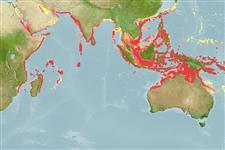>
Eupercaria/misc (Various families in series Eupercaria) >
Lethrinidae (Emperors or scavengers) > Lethrininae
Etymology: Lethrinus: Greek, lethrinia, a fish pertaining to genus Pagellus.
More on author: Valenciennes.
Environment: milieu / climate zone / depth range / distribution range
Écologie
marin récifal; non migrateur; profondeur 10 - 200 m (Ref. 2295). Tropical; 32°N - 23°S, 32°E - 160°E
Indo-West Pacific: widespread, including the Red Sea, Arabian (Persian) Gulf, East Africa to Sri Lanka, to the Ryukyu Islands and Papua New Guinea. Also recorded from Micronesia (Ref. 3807) and French Polynesia (Ref. 4517) but these are probably misidentifications of Lethrinus olivaceus.
Length at first maturity / Taille / Poids / Âge
Maturity: Lm 29.1 range ? - ? cm
Max length : 80.0 cm TL mâle / non sexé; (Ref. 48635); common length : 40.0 cm TL mâle / non sexé; (Ref. 2295); poids max. publié: 4.9 kg (Ref. 40637)
Épines dorsales (Total) : 10; Rayons mous dorsaux (Total) : 9; Épines anales: 3; Rayons mous anaux: 8. The snout is moderately long, its dorsal profile slightly concave. Body color is bluish gray or brown often with scattered irregular dark blotches on sides; sometimes three dark streaks radiate forward from the eye. The fins are pale or orangish.
Found over sandy areas near coral reefs (Ref. 30573). Feeds on fish, crustaceans, cephalopods, and polychaetes. Swims in small schools sometimes together with L. olivaceous. Utilized as a food fish. Maximum depth reported taken from Ref. 9773.
Life cycle and mating behavior
Maturité | Reproduction | Frai | Œufs | Fécondité | Larves
Carpenter, K.E. and G.R. Allen, 1989. FAO Species Catalogue. Vol. 9. Emperor fishes and large-eye breams of the world (family Lethrinidae). An annotated and illustrated catalogue of lethrinid species known to date. FAO Fish. Synop. 125(9):118 p. Rome: FAO. (Ref. 2295)
Statut dans la liste rouge de l'IUCN (Ref. 130435: Version 2024-1)
Menace pour l'homme
Reports of ciguatera poisoning (Ref. 31637)
Utilisations par l'homme
Pêcheries: commercial; pêche sportive: oui
Outils
Articles particuliers
Télécharger en XML
Sources Internet
Estimates based on models
Preferred temperature (Ref.
123201): 24.7 - 29.1, mean 28.1 °C (based on 1954 cells).
Phylogenetic diversity index (Ref.
82804): PD
50 = 0.5000 [Uniqueness, from 0.5 = low to 2.0 = high].
Bayesian length-weight: a=0.01175 (0.00760 - 0.01816), b=2.97 (2.85 - 3.09), in cm total length, based on LWR estimates for this species & Genus-body shape (Ref.
93245).
Niveau trophique (Ref.
69278): 3.8 ±0.51 se; based on food items.
Generation time: 5.5 ( na - na) years. Estimated as median ln(3)/K based on 2
growth studies.
Résilience (Ref.
120179): Milieu, temps minimum de doublement de population : 1,4 à 4,4 années (K=0.20).
Prior r = 0.57, 95% CL = 0.37 - 0.85, Based on 1 data-limited stock assessment.
Fishing Vulnerability (Ref.
59153): Moderate to high vulnerability (46 of 100).
Climate Vulnerability (Ref.
125649): Very high vulnerability (89 of 100).
Nutrients (Ref.
124155): Calcium = 30.8 [21.6, 41.5] mg/100g; Iron = 0.726 [0.499, 0.997] mg/100g; Protein = 20.3 [17.7, 22.4] %; Omega3 = 0.124 [0.092, 0.165] g/100g; Selenium = 51 [27, 76] μg/100g; VitaminA = 25.1 [5.6, 129.2] μg/100g; Zinc = 1.81 [1.40, 2.24] mg/100g (wet weight); based on
nutrient studies.
